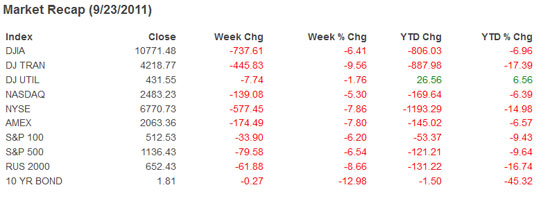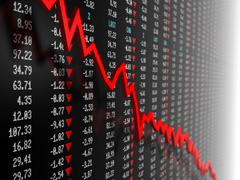 Fed Chairman Ben Bernanke set the world on fire this week as his latest scheme to “twist” long term interest rates lower pleased no one and triggered a 737 point drop in the Dow. In addition, the Fed panicked investors by admitting that there were “significant downside risks to the economic outlook”.
Fed Chairman Ben Bernanke set the world on fire this week as his latest scheme to “twist” long term interest rates lower pleased no one and triggered a 737 point drop in the Dow. In addition, the Fed panicked investors by admitting that there were “significant downside risks to the economic outlook”.
Virtually every asset class except U.S. treasuries went into full scale meltdowns. The U.S. stock market registered its worst weekly drop since the dark days of October 2008 when the U.S. banking system was collapsing.
The rush to liquidity and forced margin selling sent precious metal prices into a tailspin. London silver plunged by $7.07 or 18%, to $32.90, the biggest decline since 1987. Gold, as measured by the closing London PM Fix Price, dropped $105 on the week to $1,689, the largest weekly decline since 1983. Spot prices for both gold and silver continued lower in New York afternoon trading with gold settling at $1658.20 and silver at $31.03.
Platinum dropped by $147 on the week to $1,651 and palladium dropped by $73 to $659 for losses of 8.18% and 9.97%, respectively. Silver, with 60% of its demand relating to industrial use, took the largest plunge in the precious metals group as economic indicators pointed to a rapidly slowing economy worldwide.
| Precious Metals Prices | Sept 23 | ||
| 9/23PM Fix | Weekly Change | ||
| Gold | $1,689.00 | -105.00 | -5.85% |
| Silver | $32.90 | -7.07 | -17.69% |
| Platinum | $1,651.00 | -147.00 | -8.18% |
| Palladium | $659.00 | -73.00 | -9.97% |
Although the sharp declines in gold and silver are unsettling, the fundamental reasons for owning gold and silver remain intact. The rapid price increases in gold and silver since July attracted large investment flows from hedge funds and other short term speculators, who rapidly liquidate large positions based on short term technical sell signals.
Despite this week’s panic selling, long term gold investors have seen their investment rise from $1,405.50 at the beginning of the year, for a gain of $283.50 (20.2%). Silver, despite this week’s painful sell off, is still higher by $2.23 or 7.3% from the beginning of the year, as measured by the closing London PM Fix Price.
For additional perspective on the relative performance of the gold and silver markets, here’s the record for various stock indices and the 10 year bond since the beginning of 2011. (Note that the 10 year bond shows yield, not price.)
Meanwhile, as the global financial system rapidly moves towards the precipice, faith in the ability of governments to contain the crisis is quickly eroding. 2011 is not a replay of the 2008 financial meltdown – it’s much more dangerous. The sovereign governments that “saved the system” in 2008 incurred massive amounts of debt which have brought them to the brink of insolvency. The bankruptcy of one country could ignite a financial firestorm that world governments cannot contain.
The inability of European leaders to effectively act in concert to resolve the Euro debt crisis has drawn the United States into the center of the crisis. According to The New York Times, the U.S. is pushing Europe to mount a massive bailout to avoid financial Armageddon.
The Obama administration, increasingly alarmed by the spillover effects of Europe’s financial crisis, has begun an intensive lobbying campaign to persuade Chancellor Angela Merkel of Germany and other leaders to ramp up efforts to stem any contagion from the debt crisis in Greece.
In phone calls and meetings over the last week, President Obama urged Mrs. Merkel and President Nicolas Sarkozy of France to take coordinated measures — including spending billions in additional funds to bail out Greece and bolster European financial institutions — to prevent Greece’s debt woes from spreading to its neighbors.
“The biggest single risk to the United States today is that the European situation will spiral out of control,” said Edwin M. Truman, a former Treasury official who is now at the Peterson Institute for International Economics. “Europe is not going to save the U.S. economy, but it could be the straw that breaks it.”
Kenneth Rogoff, a Harvard economist who has written about the history of financial crises, puts Europe’s effect on the United States in blunt political terms. “The downside scenario is awful,” he said…
American officials have also emphasized the Fed’s outsize role in responding to the financial crisis here and urged Europe to view the Fed as a model. It made trillions of dollars in loans so that investors remained able to buy and sell a wide range of financial products.
Given the risks to the United States economy from a banking collapse and sovereign defaults in Europe, anyone who thinks that the United States will not be getting deeply involved in the financial bailout of Europe is delusional. The “rescue” of Europe will ultimately involve the same techniques (zero interest rates and money printing) used by Bernanke in the United States. The resulting negative interest rates and worldwide debasement of paper currencies will ultimately send gold soaring to new highs.

 By the close of trading on Wednesday, May 4th, the silver market had experienced significant selling pressure that drove prices down by 17.3% from Thursday, April 28th. This sell off corresponded exactly to a series of increased margin requirements by the COMEX for trading silver futures contracts.
By the close of trading on Wednesday, May 4th, the silver market had experienced significant selling pressure that drove prices down by 17.3% from Thursday, April 28th. This sell off corresponded exactly to a series of increased margin requirements by the COMEX for trading silver futures contracts.